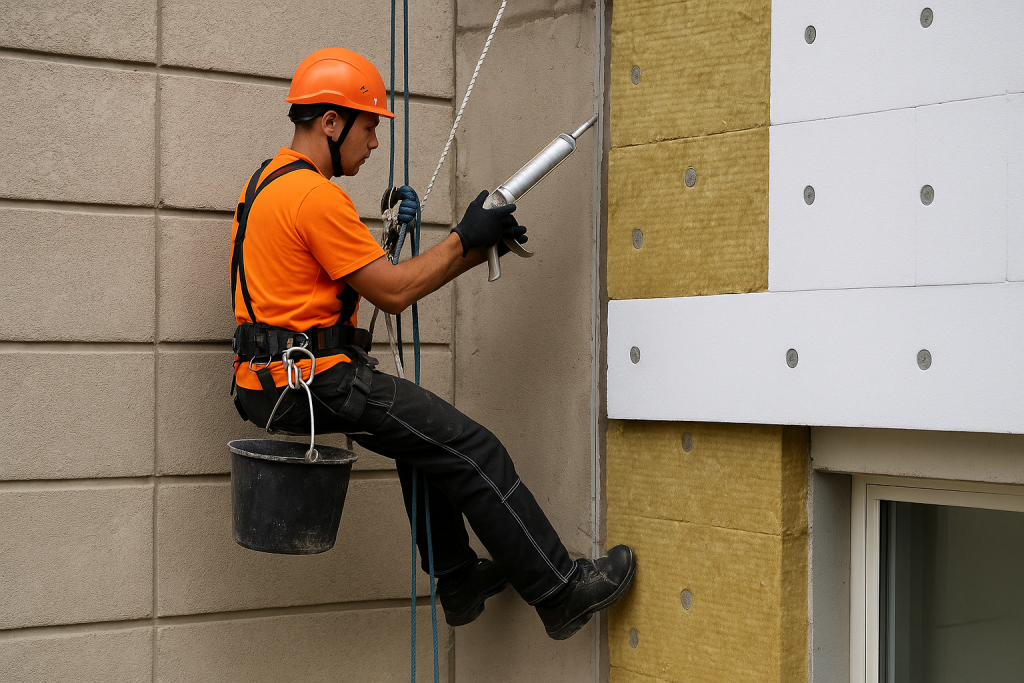Sealing joints and insulating the facade: should these tasks be combined?

Sealing joints and insulating the facade are two key steps that help improve the energy efficiency and durability of buildings. These works are aimed at improving thermal insulation, protecting against external influences, and increasing the overall stability of the structure. But the question arises: should these works be combined or is it better to perform them separately? In this article, we will look at the advantages and disadvantages of combining these processes, as well as give recommendations on when it is most beneficial to do so.
Why is sealing joints important?
Sealing facade joints is necessary to prevent moisture, dirt, and air from penetrating, as well as to improve the thermal insulation characteristics of the building. Joints and cracks between building elements are vulnerable points through which heat loss occurs and water can enter. This can lead to structural damage, mold growth, and deterioration of the indoor climate. Sealing helps prevent all these problems, improving not only thermal insulation but also the durability of the facade.
Sealing joints also prevents the growth of mold and mildew, which can occur due to moisture penetration. This is important not only for preserving facade materials, but also for the health of residents, as mold and mildew can deteriorate indoor air quality.
What are the benefits of facade insulation?
Facade insulation is a process aimed at improving the energy efficiency of a building and creating comfortable living conditions. It significantly reduces heat loss through walls, which helps to reduce heating costs and maintain a stable temperature inside the premises.
Insulating the facade not only reduces heating costs, but also helps to reduce noise levels, especially if the building is located in a noisy urban environment. Insulation helps to reduce external noise levels, creating a more comfortable atmosphere inside.
There are several types of insulation, each with its own advantages. For example, mineral wool has good thermal and sound insulation properties, foam plastic is more affordable, and extruded polystyrene foam is highly durable and long-lasting.
Is it worth combining joint sealing and facade insulation?
Combining joint sealing and facade insulation has its pros and cons. On the one hand, it saves time and money, as both processes can be performed simultaneously. Performing these tasks together helps to improve the thermal insulation of the building, as sealing eliminates gaps and cracks through which heat can escape, and insulation helps to reduce heat loss.
However, it is important to remember that in some cases, these tasks need to be separated. For example, insulating a facade may require preliminary repairs or structural reinforcement, which must be taken into account before sealing the joints. It is also important to choose compatible materials for sealing and insulation to avoid conflicts between them.
Advantages of combining works
- Reduction in the time required to complete the work.
- Improved thermal insulation and facade protection.
- Savings on materials and labor costs if the work is performed simultaneously.
Possible problems when combining
- Some sealing and insulation materials may be incompatible with each other.
- Insulating the facade may require additional preparatory work, which may affect the quality of the seal.
- Incompatibility of conditions for performing both tasks may lead to ineffective results.
When is it best to divide these tasks?
Despite the advantages of combining these processes, there are cases when it is better to separate joint sealing and facade insulation. Separating these works may be necessary if the facade requires preliminary repairs that must be carried out before insulation. It is important that joint sealing is performed properly before insulation begins, otherwise the insulation may interfere with this process.
The division of labor may also be justified if several different types of sealing and insulation materials are used, which may be incompatible with each other.
Sealing joints and insulating the facade are important processes that can be performed either simultaneously or separately, depending on the condition of the building and the materials selected. Combining these tasks saves time and money, as well as increasing the energy efficiency and durability of the building. However, in some cases, it may be more beneficial to separate these processes. It is important to consider all the features of the building and consult professionals to choose the best approach.
Interesting articles:
How climbers help in responding to accidents at height: examples of unusual cases
When urgent replacement of a double-glazed window is required: common emergency situations
